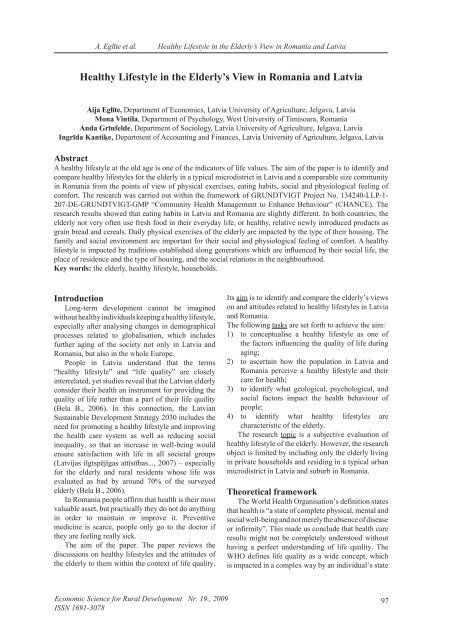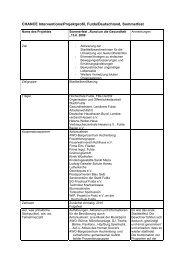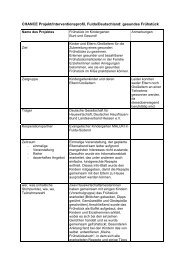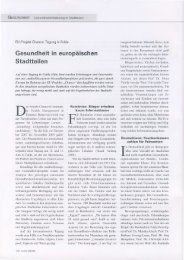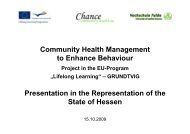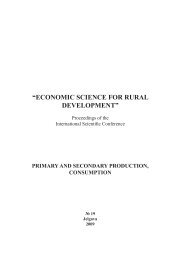Healthy Lifestyle in the Elderly's View in Romania and Latvia
Healthy Lifestyle in the Elderly's View in Romania and Latvia
Healthy Lifestyle in the Elderly's View in Romania and Latvia
Create successful ePaper yourself
Turn your PDF publications into a flip-book with our unique Google optimized e-Paper software.
A. Eglīte et al. <strong>Healthy</strong> <strong>Lifestyle</strong> <strong>in</strong> <strong>the</strong> Elderly’s <strong>View</strong> <strong>in</strong> <strong>Romania</strong> <strong>and</strong> <strong>Latvia</strong><br />
<strong>Healthy</strong> <strong>Lifestyle</strong> <strong>in</strong> <strong>the</strong> Elderly’s <strong>View</strong> <strong>in</strong> <strong>Romania</strong> <strong>and</strong> <strong>Latvia</strong><br />
Aija Eglīte, Department of Economics, <strong>Latvia</strong> University of Agriculture, Jelgava, <strong>Latvia</strong><br />
Mona V<strong>in</strong>tila, Department of Psychology, West University of Timisoara, <strong>Romania</strong><br />
Anda Grīnfelde, Department of Sociology, <strong>Latvia</strong> University of Agriculture, Jelgava, <strong>Latvia</strong><br />
Ingrīda Kantiķe, Department of Account<strong>in</strong>g <strong>and</strong> F<strong>in</strong>ances, <strong>Latvia</strong> University of Agriculture, Jelgava, <strong>Latvia</strong><br />
Abstract<br />
A healthy lifestyle at <strong>the</strong> old age is one of <strong>the</strong> <strong>in</strong>dicators of life values. The aim of <strong>the</strong> paper is to identify <strong>and</strong><br />
compare healthy lifestyles for <strong>the</strong> elderly <strong>in</strong> a typical microdistrict <strong>in</strong> <strong>Latvia</strong> <strong>and</strong> a comparable size community<br />
<strong>in</strong> <strong>Romania</strong> from <strong>the</strong> po<strong>in</strong>ts of view of physical exercises, eat<strong>in</strong>g habits, social <strong>and</strong> physiological feel<strong>in</strong>g of<br />
comfort. The research was carried out with<strong>in</strong> <strong>the</strong> framework of GRUNDTVIGT Project No. 134240-LLP-1-<br />
207-DE-GRUNDTVIGT-GMP “Community Health Management to Enhance Behaviour” (CHANCE). The<br />
research results showed that eat<strong>in</strong>g habits <strong>in</strong> <strong>Latvia</strong> <strong>and</strong> <strong>Romania</strong> are slightly different. In both countries, <strong>the</strong><br />
elderly not very often use fresh food <strong>in</strong> <strong>the</strong>ir everyday life, or healthy, relative newly <strong>in</strong>troduced products as<br />
gra<strong>in</strong> bread <strong>and</strong> cereals. Daily physical exercises of <strong>the</strong> elderly are impacted by <strong>the</strong> type of <strong>the</strong>ir hous<strong>in</strong>g. The<br />
family <strong>and</strong> social environment are important for <strong>the</strong>ir social <strong>and</strong> physiological feel<strong>in</strong>g of comfort. A healthy<br />
lifestyle is impacted by traditions established along generations which are <strong>in</strong>fluenced by <strong>the</strong>ir social life, <strong>the</strong><br />
place of residence <strong>and</strong> <strong>the</strong> type of hous<strong>in</strong>g, <strong>and</strong> <strong>the</strong> social relations <strong>in</strong> <strong>the</strong> neighbourhood.<br />
Key words: <strong>the</strong> elderly, healthy lifestyle, households.<br />
Introduction<br />
Long-term development cannot be imag<strong>in</strong>ed<br />
without healthy <strong>in</strong>dividuals keep<strong>in</strong>g a healthy lifestyle,<br />
especially after analys<strong>in</strong>g changes <strong>in</strong> demographical<br />
processes related to globalisation, which <strong>in</strong>cludes<br />
fur<strong>the</strong>r ag<strong>in</strong>g of <strong>the</strong> society not only <strong>in</strong> <strong>Latvia</strong> <strong>and</strong><br />
<strong>Romania</strong>, but also <strong>in</strong> <strong>the</strong> whole Europe.<br />
People <strong>in</strong> <strong>Latvia</strong> underst<strong>and</strong> that <strong>the</strong> terms<br />
“healthy lifestyle” <strong>and</strong> “life quality” are closely<br />
<strong>in</strong>terrelated, yet studies reveal that <strong>the</strong> <strong>Latvia</strong>n elderly<br />
consider <strong>the</strong>ir health an <strong>in</strong>strument for provid<strong>in</strong>g <strong>the</strong><br />
quality of life ra<strong>the</strong>r than a part of <strong>the</strong>ir life quality<br />
(Bela B., 2006). In this connection, <strong>the</strong> <strong>Latvia</strong>n<br />
Susta<strong>in</strong>able Development Strategy 2030 <strong>in</strong>cludes <strong>the</strong><br />
need for promot<strong>in</strong>g a healthy lifestyle <strong>and</strong> improv<strong>in</strong>g<br />
<strong>the</strong> health care system as well as reduc<strong>in</strong>g social<br />
<strong>in</strong>equality, so that an <strong>in</strong>crease <strong>in</strong> well-be<strong>in</strong>g would<br />
ensure satisfaction with life <strong>in</strong> all societal groups<br />
(Latvijas ilgtspējīgas attīstības..., 2007) – especially<br />
for <strong>the</strong> elderly <strong>and</strong> rural residents whose life was<br />
evaluated as bad by around 70% of <strong>the</strong> surveyed<br />
elderly (Bela B., 2006).<br />
In <strong>Romania</strong> people affirm that health is <strong>the</strong>ir most<br />
valuable asset, but practically <strong>the</strong>y do not do anyth<strong>in</strong>g<br />
<strong>in</strong> order to ma<strong>in</strong>ta<strong>in</strong> or improve it. Preventive<br />
medic<strong>in</strong>e is scarce, people only go to <strong>the</strong> doctor if<br />
<strong>the</strong>y are feel<strong>in</strong>g really sick.<br />
The aim of <strong>the</strong> paper. The paper reviews <strong>the</strong><br />
discussions on healthy lifestyles <strong>and</strong> <strong>the</strong> attitudes of<br />
<strong>the</strong> elderly to <strong>the</strong>m with<strong>in</strong> <strong>the</strong> context of life quality.<br />
Its aim is to identify <strong>and</strong> compare <strong>the</strong> elderly’s views<br />
on <strong>and</strong> attitudes related to healthy lifestyles <strong>in</strong> <strong>Latvia</strong><br />
<strong>and</strong> <strong>Romania</strong>.<br />
The follow<strong>in</strong>g tasks are set forth to achieve <strong>the</strong> aim:<br />
1) to conceptualise a healthy lifestyle as one of<br />
<strong>the</strong> factors <strong>in</strong>fluenc<strong>in</strong>g <strong>the</strong> quality of life dur<strong>in</strong>g<br />
ag<strong>in</strong>g;<br />
2) to ascerta<strong>in</strong> how <strong>the</strong> population <strong>in</strong> <strong>Latvia</strong> <strong>and</strong><br />
<strong>Romania</strong> perceive a healthy lifestyle <strong>and</strong> <strong>the</strong>ir<br />
care for health;<br />
3) to identify what geological, psychological, <strong>and</strong><br />
social factors impact <strong>the</strong> health behaviour of<br />
people;<br />
4) to identify what healthy lifestyles are<br />
characteristic of <strong>the</strong> elderly.<br />
The research topic is a subjective evaluation of<br />
healthy lifestyle of <strong>the</strong> elderly. However, <strong>the</strong> research<br />
object is limited by <strong>in</strong>clud<strong>in</strong>g only <strong>the</strong> elderly liv<strong>in</strong>g<br />
<strong>in</strong> private households <strong>and</strong> resid<strong>in</strong>g <strong>in</strong> a typical urban<br />
microdistrict <strong>in</strong> <strong>Latvia</strong> <strong>and</strong> suburb <strong>in</strong> <strong>Romania</strong>.<br />
Theoretical framework<br />
The World Health Organisation’s def<strong>in</strong>ition states<br />
that health is “a state of complete physical, mental <strong>and</strong><br />
social well-be<strong>in</strong>g <strong>and</strong> not merely <strong>the</strong> absence of disease<br />
or <strong>in</strong>firmity”. This made us conclude that health care<br />
results might not be completely understood without<br />
hav<strong>in</strong>g a perfect underst<strong>and</strong><strong>in</strong>g of life quality. The<br />
WHO def<strong>in</strong>es life quality as a wide concept, which<br />
is impacted <strong>in</strong> a complex way by an <strong>in</strong>dividual’s state<br />
Economic Science for Rural Development Nr. 19., 2009<br />
ISSN 1691-3078<br />
97
A. Eglīte et al. <strong>Healthy</strong> <strong>Lifestyle</strong> <strong>in</strong> <strong>the</strong> Elderly’s <strong>View</strong> <strong>in</strong> <strong>Romania</strong> <strong>and</strong> <strong>Latvia</strong><br />
of health, psychological state, beliefs, relations with<br />
o<strong>the</strong>r people <strong>and</strong> <strong>the</strong> most significant environmental<br />
factors (Smith A., 2000).<br />
Both care <strong>and</strong> carelessness for one’s own health<br />
is a result of <strong>in</strong>teraction among psychological,<br />
physical, <strong>and</strong> social factors. Ann Bowl<strong>in</strong>g calls it <strong>the</strong><br />
biopsychosocial health model or “health lifestyle”.<br />
A health lifestyle is “<strong>in</strong>tentional health behaviours<br />
based on <strong>the</strong> alternatives available <strong>in</strong> each particular<br />
situation” (Bowl<strong>in</strong>g A., 2002).<br />
Health behaviour is:<br />
1) an activity carried out by a person consider<strong>in</strong>g<br />
himself / herself healthy <strong>in</strong> order to prevent a<br />
disease;<br />
2) activities that are carried out irrespective<br />
of <strong>the</strong> state of health <strong>in</strong> order to prevent<br />
diseases;<br />
3) any behaviour performed by a person with <strong>the</strong><br />
purpose to protect, promote, or preserve his/her<br />
health irrespective of an underst<strong>and</strong><strong>in</strong>g of his/her<br />
state of health;<br />
4) an activity for reduc<strong>in</strong>g <strong>the</strong> risk of gett<strong>in</strong>g ill,<br />
<strong>and</strong> a behaviour hav<strong>in</strong>g as purpose to promote<br />
health.<br />
The care for health is a general notion of one’s<br />
health as a measure of values that ensures sufficient<br />
life quality, a sufficiently long life, <strong>and</strong> a good<br />
physical feel<strong>in</strong>g.<br />
The care for health is exposed as a holistic<br />
lifestyle (system of health habits), <strong>in</strong> which health is<br />
<strong>in</strong>cluded <strong>in</strong> <strong>the</strong> basic values of life <strong>and</strong> <strong>in</strong> <strong>the</strong> concept<br />
of life quality. Knowledge on <strong>the</strong> constitution <strong>and</strong><br />
functions of one’s own organism <strong>and</strong> delivery of<br />
<strong>in</strong>formation on available health care services allow<br />
people to adequately act <strong>in</strong> case of illness (system<br />
of disease habits).<br />
Therefore <strong>the</strong> health behaviour determ<strong>in</strong>es three<br />
types of categories:<br />
1. Individual categories.<br />
2. Social <strong>and</strong> cultural categories.<br />
3. Capability categories.<br />
What does it mean to care for health? Does<br />
it mean prevent<strong>in</strong>g diseases <strong>and</strong> absta<strong>in</strong><strong>in</strong>g<br />
from unhealthy habits or try<strong>in</strong>g to ma<strong>in</strong>ta<strong>in</strong> <strong>the</strong><br />
functionality of <strong>the</strong> body <strong>and</strong> m<strong>in</strong>d given by nature;<br />
not only ma<strong>in</strong>ta<strong>in</strong><strong>in</strong>g, but also promot<strong>in</strong>g one’s<br />
own health?<br />
Research methods. The research <strong>in</strong> this paper<br />
is focused on sociological surveys <strong>in</strong> <strong>the</strong> form of<br />
<strong>in</strong>terviews <strong>and</strong> on data process<strong>in</strong>g us<strong>in</strong>g statistical<br />
research methods. The research is unique due<br />
to <strong>the</strong> fact that it was carried out <strong>in</strong> two new EU<br />
member states simultaneously. A typical part of a<br />
town, specific to each country, was chosen for <strong>the</strong><br />
research object. The research subject <strong>in</strong> this paper is<br />
<strong>the</strong> elderly.<br />
Research results<br />
RAF microdistrict <strong>in</strong> <strong>the</strong> city of Jelgava acquired<br />
its name from Riga Autobus (m<strong>in</strong>ibus) Factory which<br />
was located <strong>in</strong> Jelgava. Dwell<strong>in</strong>g houses were built<br />
for <strong>the</strong> factory’s employees <strong>in</strong> <strong>the</strong> vic<strong>in</strong>ity of <strong>the</strong><br />
factory. The microdistrict is situated <strong>in</strong> <strong>the</strong> North<br />
East of Jelgava, on <strong>the</strong> right bank of <strong>the</strong> river Lielupe,<br />
around 3 km away from <strong>the</strong> centre of Jelgava towards<br />
<strong>the</strong> capital city of Riga. As of January 1, 2008, 4520<br />
residents lived <strong>in</strong> <strong>the</strong> microdisctrict’s territory which<br />
was chosen for <strong>the</strong> research. The average size of<br />
households <strong>in</strong> RAF is 2.89. Natural gas <strong>and</strong> electric<br />
power is supplied to RAF microdistrict; it has a<br />
centralised water supply system <strong>and</strong> a sewage system<br />
which is connected to <strong>the</strong> city’s water treatment plant.<br />
A block <strong>in</strong> <strong>the</strong> RAF microdistrict consists of fivestorey<br />
<strong>and</strong> n<strong>in</strong>e-storey dwell<strong>in</strong>g houses which were<br />
built <strong>in</strong> <strong>the</strong> 1970s. The chosen territory has a school<br />
with a pool, a sports hall <strong>and</strong> a sports ground, which<br />
is available also to <strong>the</strong> microdistrict’s residents, 2<br />
k<strong>in</strong>dergartens, 4 small food stores, a baker’s store, a<br />
household goods store <strong>and</strong> 3 shopp<strong>in</strong>g centres, a café<br />
<strong>and</strong> a fast food restaurant, a post office, 2 drugstores,<br />
a dentist’s office, a doctor’s office, a library, 3<br />
gambl<strong>in</strong>g halls, 3 playgrounds for children, a dry<br />
clean<strong>in</strong>g shop <strong>and</strong> a laundry, a footwear repair shop,<br />
a petrol <strong>and</strong> gas station, <strong>and</strong> a car repair shop. There<br />
is a forest just across Loka Magistrale Street, which<br />
is a favourite rest<strong>in</strong>g place for Jelgava residents. Next<br />
to <strong>the</strong> forest, <strong>the</strong>re is a guarded complex of private<br />
garages, a tombstone shop, <strong>and</strong> Bērzi cemetery. S<strong>in</strong>ce<br />
<strong>the</strong> RAF microdistrict was build dur<strong>in</strong>g <strong>the</strong> Soviet<br />
times, no church is available.<br />
Dumbravita is a suburb of Timisoara, which has<br />
developed from a small village dur<strong>in</strong>g <strong>the</strong> first 20<br />
years, becom<strong>in</strong>g a suburb of Timisoara. It has 2915<br />
<strong>in</strong>habitants <strong>and</strong> 1417 households. The average size<br />
of households <strong>in</strong> Dumbravita is 2.06. There is a<br />
school, 1 k<strong>in</strong>dergarten; <strong>the</strong>re are several churches <strong>and</strong><br />
a relatively large forest – 648 ha. 27 teachers work<br />
<strong>in</strong> Dumbravita <strong>and</strong> 2 doctors. There are very few<br />
unemployed people out of those of work<strong>in</strong>g age. A<br />
little more than half of <strong>the</strong> population is represented by<br />
<strong>the</strong> females – 52.63% <strong>and</strong> <strong>the</strong> rest by <strong>the</strong> males. There<br />
are <strong>Romania</strong>ns, Hungarians <strong>and</strong> German nationality<br />
<strong>in</strong>habitants, ma<strong>in</strong>ly Orthodox <strong>and</strong> Catholics.<br />
Empirical <strong>in</strong>formation was simultaneously ga<strong>in</strong>ed<br />
dur<strong>in</strong>g May-June 2008 while conduct<strong>in</strong>g a quantitative<br />
survey of communities <strong>in</strong> <strong>the</strong> RAF microdistrict <strong>in</strong><br />
Jelgava <strong>and</strong> <strong>in</strong> Dumbraviat a suburb of <strong>the</strong> town of<br />
Timisoara. The total number of respondents was 255 <strong>in</strong><br />
Jelgava, of whom 44 were at <strong>the</strong> age of 61 <strong>and</strong> older (8<br />
males) – 26 <strong>Latvia</strong>ns <strong>and</strong> 18 Russians. In Dumbravita<br />
200 <strong>in</strong>dividuals were questioned, of whom 90 were<br />
at <strong>the</strong> age of 61 <strong>and</strong> older. In Jelgava <strong>the</strong> elderly live<br />
as s<strong>in</strong>gles (43%) or toge<strong>the</strong>r with a partner or a child<br />
98 Economic Science for Rural Development Nr. 19, 2009<br />
ISSN 1691-3078
A. Eglīte et al. <strong>Healthy</strong> <strong>Lifestyle</strong> <strong>in</strong> <strong>the</strong> Elderly’s <strong>View</strong> <strong>in</strong> <strong>Romania</strong> <strong>and</strong> <strong>Latvia</strong><br />
Figure 1. Number of <strong>in</strong>dividuals <strong>in</strong> <strong>the</strong> households of <strong>the</strong> elderly <strong>in</strong> <strong>Latvia</strong> <strong>and</strong> <strong>Romania</strong><br />
Figure 2. Size of <strong>the</strong> homes of <strong>the</strong> elderly <strong>in</strong> Jelgava <strong>and</strong> Dumbravita<br />
(39%), <strong>the</strong> rest of <strong>the</strong>m – <strong>in</strong> households of several<br />
<strong>in</strong>dividuals. In Timisoara <strong>the</strong> majority of <strong>the</strong> elderly<br />
live <strong>in</strong> couples, <strong>the</strong> size of o<strong>the</strong>r households is about<br />
<strong>the</strong> same, but <strong>the</strong> proportion of <strong>the</strong> s<strong>in</strong>gle elderly is<br />
only 13% (Figure 1).<br />
The elderly <strong>in</strong> <strong>Romania</strong> evaluate <strong>the</strong>ir material<br />
position, as compared with <strong>the</strong> residents liv<strong>in</strong>g <strong>in</strong><br />
<strong>the</strong>ir community, as equivalent, but some of <strong>the</strong>m - as<br />
above <strong>the</strong> average. In <strong>Latvia</strong> <strong>the</strong> elderly evaluate <strong>the</strong>ir<br />
material position as <strong>the</strong> same or worse, but no one<br />
evaluates it as better than that of his/her neighbours.<br />
The <strong>Romania</strong>n elderly evaluate <strong>the</strong>ir material position<br />
as slightly better, as compared with <strong>the</strong>ir community<br />
residents, than it is <strong>in</strong> <strong>Latvia</strong>.<br />
Both <strong>the</strong> elderly <strong>in</strong> Dumbravita <strong>and</strong> those <strong>in</strong><br />
Jelgava feel well <strong>in</strong> <strong>the</strong>ir homes, <strong>and</strong> <strong>the</strong>y like<br />
<strong>the</strong>ir apartments or houses. In Jelgava 73% of <strong>the</strong><br />
elderly are <strong>the</strong> owners of <strong>the</strong>ir apartments, while <strong>in</strong><br />
Dumbravita – 97%. In both countries <strong>the</strong> proportion<br />
of apartment owners among <strong>the</strong> elderly is slightly<br />
above <strong>the</strong> average <strong>in</strong>dicator.<br />
In Jelgava <strong>the</strong> size of apartments is less than 60m 2 <strong>in</strong><br />
most cases, whereas <strong>in</strong> Timisoara it is more than 100<br />
m 2 (Figure 2).<br />
The elderly try to cope with <strong>the</strong>ir household work<br />
<strong>the</strong>mselves. Almost two thirds of <strong>the</strong> <strong>Latvia</strong>n elderly<br />
believe that <strong>the</strong>y need no help <strong>in</strong> <strong>the</strong>ir household<br />
work, but 25% of <strong>the</strong>m need it <strong>in</strong> clean<strong>in</strong>g up <strong>the</strong>ir<br />
Economic Science for Rural Development Nr. 19., 2009<br />
ISSN 1691-3078<br />
99
A. Eglīte et al. <strong>Healthy</strong> <strong>Lifestyle</strong> <strong>in</strong> <strong>the</strong> Elderly’s <strong>View</strong> <strong>in</strong> <strong>Romania</strong> <strong>and</strong> <strong>Latvia</strong><br />
Figure 3. I read <strong>the</strong> <strong>in</strong>formation on packages about <strong>the</strong> <strong>in</strong>gredients <strong>and</strong> energy value of food products<br />
apartments. The <strong>Romania</strong>n elderly need help only for<br />
shopp<strong>in</strong>g, clean<strong>in</strong>g up <strong>the</strong>ir apartments, <strong>and</strong> fill<strong>in</strong>g <strong>in</strong><br />
documents.<br />
55% of <strong>the</strong> elderly <strong>in</strong> <strong>Latvia</strong> <strong>and</strong> respectively 51%<br />
<strong>in</strong> <strong>Romania</strong> believe that <strong>the</strong>y are well <strong>in</strong>formed about<br />
a healthy lifestyle from <strong>the</strong> po<strong>in</strong>ts of view of physical<br />
exercises, healthy food, <strong>and</strong> social <strong>and</strong> psychological<br />
feel<strong>in</strong>g of comfort. 41% of <strong>the</strong> <strong>Romania</strong>n elderly <strong>and</strong><br />
23% of <strong>the</strong> <strong>Latvia</strong>n elderly said <strong>the</strong>y were partially<br />
<strong>in</strong>formed about a healthy lifestyle from <strong>the</strong> po<strong>in</strong>t of<br />
view of physical exercises. The <strong>Latvia</strong>n elderly feel<br />
to be better <strong>in</strong>formed than <strong>the</strong> <strong>Romania</strong>n elderly about<br />
physical exercises. 78% of <strong>the</strong> <strong>Romania</strong>n elderly <strong>and</strong><br />
61% of <strong>the</strong> Jelgava elderly are well <strong>in</strong>formed about<br />
healthy food, while 16% of <strong>the</strong> <strong>Latvia</strong>n elderly <strong>and</strong><br />
only 1% of <strong>the</strong> <strong>Romania</strong>n elderly feel un<strong>in</strong>formed.<br />
The <strong>Romania</strong>n elderly also feel to be better <strong>in</strong>formed<br />
about <strong>the</strong> social <strong>and</strong> mental feel<strong>in</strong>g of comfort as an<br />
element of healthy lifestyle.<br />
The majority of <strong>the</strong> elderly <strong>in</strong> both countries does not<br />
believe that keep<strong>in</strong>g a healthy lifestyle is bor<strong>in</strong>g.<br />
In <strong>Latvia</strong> <strong>the</strong> elderly get <strong>in</strong>formation about<br />
healthy lifestyles mostly from TV, followed by a<br />
doctor <strong>and</strong> friends, whereas <strong>in</strong> <strong>Romania</strong> <strong>the</strong> ma<strong>in</strong><br />
source of <strong>in</strong>formation about healthy lifestyles is<br />
a doctor, followed by TV <strong>and</strong> <strong>the</strong> family. For <strong>the</strong><br />
<strong>Latvia</strong>n elderly, <strong>the</strong> family as a source of <strong>in</strong>formation<br />
takes <strong>the</strong> fifth position after neighbours. It might be<br />
expla<strong>in</strong>ed by <strong>the</strong> fact that <strong>the</strong> <strong>Latvia</strong>n elderly live<br />
mostly as s<strong>in</strong>gles, but <strong>the</strong> <strong>Romania</strong>n elderly mostly<br />
live <strong>in</strong> families.<br />
Therefore if <strong>the</strong> <strong>Latvia</strong>n elderly have problems,<br />
<strong>the</strong>y mostly try to h<strong>and</strong>le <strong>the</strong>m <strong>the</strong>mselves (57%) as<br />
compared with <strong>the</strong> <strong>Romania</strong>n elderly – 45% of <strong>the</strong>m<br />
do <strong>the</strong> same. But <strong>the</strong> <strong>Romania</strong>n elderly do not put <strong>the</strong>ir<br />
problems on o<strong>the</strong>rs because <strong>the</strong>y have not chosen as<br />
option that <strong>the</strong>y do not solve <strong>the</strong>ir problems.<br />
If <strong>the</strong>re are health, food, or movement problems,<br />
<strong>the</strong> <strong>Romania</strong>n elderly ask a doctor first <strong>and</strong> <strong>the</strong>n try to<br />
solve <strong>the</strong>m <strong>in</strong> <strong>the</strong> family, whereas <strong>in</strong> <strong>Latvia</strong> it is vice<br />
versa – <strong>the</strong>y try to solve <strong>the</strong>ir problems by <strong>the</strong> help of<br />
<strong>the</strong> family <strong>and</strong> only after <strong>the</strong>y go to see a doctor.<br />
The largest part of <strong>the</strong> elderly spends more than<br />
three hours outside <strong>the</strong>ir homes. It, of course, depends<br />
on <strong>the</strong> age <strong>and</strong> health condition. But <strong>the</strong>re are different<br />
op<strong>in</strong>ions about do<strong>in</strong>g physical exercises. The largest<br />
part of <strong>the</strong> <strong>Romania</strong>n elderly believe <strong>the</strong>y do physical<br />
exercises for more than 5 hours a week, but almost<br />
a third of <strong>the</strong> elderly from <strong>the</strong> RAF microdistrict<br />
believe <strong>the</strong>y do not do physical exercises at all. It<br />
could be expla<strong>in</strong>ed by <strong>the</strong> form of <strong>in</strong>habitation, <strong>the</strong><br />
type of home, <strong>and</strong> national traditions. In <strong>Latvia</strong>, TV is<br />
watched for a longer time than <strong>in</strong> <strong>Romania</strong>.<br />
For <strong>the</strong> RAF elderly, <strong>the</strong> five most important<br />
establishments of <strong>in</strong>frastructure are <strong>the</strong> market place,<br />
health service, recreational area, food stores, <strong>and</strong><br />
social care. The elderly from Dumbravita place <strong>the</strong><br />
church <strong>in</strong> <strong>the</strong> first position, followed by <strong>the</strong> health<br />
service, recreational area, school, k<strong>in</strong>dergarten, but<br />
<strong>the</strong> least important are <strong>the</strong> sports clubs, social centres,<br />
<strong>and</strong> educational service. The sports clubs, pool,<br />
sports ground <strong>and</strong> sports hall as well as educational<br />
<strong>in</strong>stitutions, k<strong>in</strong>dergarten <strong>and</strong> school are <strong>the</strong> least<br />
important for <strong>the</strong> RAF elderly, too.<br />
The elderly <strong>in</strong> both countries have similar eat<strong>in</strong>g<br />
habits when consum<strong>in</strong>g milk, sweets, cakes, cereals,<br />
w<strong>in</strong>e, beer, <strong>and</strong> lemonade. More than 50% of <strong>the</strong><br />
surveyed consume milk everyday, <strong>and</strong> 85% at least<br />
once a week. More than half of <strong>the</strong>m consume sweets<br />
at least once a week. The elderly of both countries do<br />
100 Economic Science for Rural Development Nr. 19, 2009<br />
ISSN 1691-3078
A. Eglīte et al. <strong>Healthy</strong> <strong>Lifestyle</strong> <strong>in</strong> <strong>the</strong> Elderly’s <strong>View</strong> <strong>in</strong> <strong>Romania</strong> <strong>and</strong> <strong>Latvia</strong><br />
Figure 4. Wheat bread consumption frequency for <strong>the</strong> elderly <strong>in</strong> <strong>Latvia</strong> <strong>and</strong> <strong>Romania</strong><br />
not consume cereals, lemonades, w<strong>in</strong>e, <strong>and</strong> beer as<br />
daily foods. The elderly <strong>in</strong> <strong>Latvia</strong> more often dr<strong>in</strong>k<br />
tea, whereas <strong>in</strong> <strong>Romania</strong> – dr<strong>in</strong>k<strong>in</strong>g water. In <strong>Latvia</strong><br />
<strong>the</strong>re are slightly more elderly who consume vitam<strong>in</strong>s<br />
everyday, but <strong>in</strong> both countries more than half of <strong>the</strong><br />
elderly use vitam<strong>in</strong>s very rarely or never.<br />
The <strong>Romania</strong>n elderly consume more margar<strong>in</strong>e<br />
everyday, but <strong>the</strong> <strong>Latvia</strong>n elderly prefer butter.<br />
The <strong>Latvia</strong>n elderly consume more vegetable oil<br />
everyday than <strong>the</strong> <strong>Romania</strong>n elderly. Fish is <strong>in</strong>cluded<br />
<strong>in</strong> <strong>the</strong> diet of <strong>the</strong> <strong>Romania</strong>ns more often than <strong>in</strong> that<br />
of <strong>the</strong> <strong>Latvia</strong>ns. Yet <strong>the</strong> <strong>Latvia</strong>ns eat more cheese<br />
as compared with <strong>the</strong> <strong>Romania</strong>ns. The <strong>Romania</strong>ns<br />
more often consume fruit <strong>and</strong> vegetables, but <strong>the</strong><br />
<strong>Latvia</strong>ns eat potatoes even several times a day.<br />
Rice <strong>and</strong> macaroni are more often consumed by <strong>the</strong><br />
<strong>Romania</strong>ns. Gra<strong>in</strong> bread is consumed everyday by<br />
25% of <strong>the</strong> Jelgava elderly, but <strong>the</strong> <strong>Romania</strong>ns eat it<br />
very rarely. The <strong>Romania</strong>ns used to eat wheat bread<br />
almost at each mealtime. In <strong>Latvia</strong> wheat bread is<br />
more favourite among those who speak Russian at<br />
home; <strong>the</strong> <strong>Latvia</strong>ns eat rye bread more often than <strong>the</strong><br />
Russians.<br />
86% of <strong>the</strong> respondents <strong>in</strong> <strong>Latvia</strong> cook food at<br />
home <strong>the</strong>mselves, <strong>in</strong> <strong>Romania</strong> respectively 64%. In<br />
<strong>Romania</strong> 58% of <strong>the</strong> elderly go shopp<strong>in</strong>g <strong>the</strong>mselves,<br />
while 75% do it <strong>in</strong> <strong>Latvia</strong>. Both <strong>the</strong> <strong>Romania</strong>n<br />
<strong>and</strong> <strong>Latvia</strong>n elderly, when buy<strong>in</strong>g food products,<br />
sometimes read <strong>the</strong> <strong>in</strong>formation on product packages,<br />
but 16% of <strong>the</strong> respondents do it always. The<br />
<strong>Romania</strong>ns more often spend <strong>the</strong>ir money on healthy<br />
food than <strong>the</strong> <strong>Latvia</strong>ns.<br />
The largest part of <strong>the</strong> elderly believes that <strong>the</strong>ir<br />
health is very important or important, but about half<br />
of <strong>the</strong> elderly <strong>in</strong> both countries regard <strong>the</strong>ir health<br />
as good or very good. Yet <strong>in</strong> <strong>Latvia</strong> <strong>the</strong> elderly have<br />
more rarely assessed <strong>the</strong>ir health as very good. Half<br />
of <strong>the</strong>m believe <strong>the</strong>ir health will not change over <strong>the</strong><br />
fur<strong>the</strong>r three years. However, <strong>the</strong> second half of <strong>the</strong><br />
<strong>Latvia</strong>n elderly are more pessimistic compared with<br />
<strong>the</strong> <strong>Romania</strong>ns. The elderly <strong>in</strong> both countries are not<br />
very <strong>in</strong>terested <strong>in</strong> active sports, but if <strong>the</strong>y were <strong>the</strong><br />
leaders of <strong>the</strong>ir microdistricts, <strong>the</strong>y would construct<br />
recreational <strong>and</strong> sports grounds <strong>and</strong> a green zone<br />
restore a health trail <strong>in</strong> <strong>the</strong> forest, repair sidewalks,<br />
<strong>in</strong>stall benches, make flowerbeds, organise various<br />
activities for <strong>the</strong> elderly, for <strong>in</strong>stance, gymnastics<br />
exercises, tea even<strong>in</strong>gs, or danc<strong>in</strong>g.<br />
Conclusions<br />
The op<strong>in</strong>ions of <strong>the</strong> elderly proved that a healthy<br />
lifestyle <strong>in</strong>clude not only healthy food, physical<br />
exercises, but also a social <strong>and</strong> psychological feel<strong>in</strong>g<br />
of comfort. A feel<strong>in</strong>g of comfort is important to <strong>the</strong><br />
elderly liv<strong>in</strong>g <strong>in</strong> multi-apartment houses not only <strong>in</strong><br />
<strong>the</strong>ir apartments, but also <strong>in</strong> <strong>the</strong> backyards, stairways,<br />
on <strong>the</strong> street or sidewalk as well as <strong>in</strong> <strong>the</strong> nearest<br />
vic<strong>in</strong>ity.<br />
It is specific <strong>in</strong> Timisoara that <strong>the</strong> elderly spend<br />
more <strong>the</strong>ir time outdoors, <strong>the</strong>refore less time is spent<br />
watch<strong>in</strong>g TV.<br />
In <strong>Latvia</strong> <strong>the</strong> first adviser <strong>in</strong> health care is <strong>the</strong><br />
family, followed by a doctor; <strong>in</strong> <strong>Romania</strong> it is vice<br />
versa. It could be expla<strong>in</strong>ed by <strong>the</strong> availability of<br />
health care <strong>in</strong> each country.<br />
There are different eat<strong>in</strong>g traditions <strong>in</strong> <strong>Latvia</strong><br />
<strong>and</strong> <strong>Romania</strong>. A healthy lifestyle is impacted by <strong>the</strong><br />
traditions established by generations <strong>in</strong> <strong>the</strong>ir social<br />
life, <strong>the</strong> place of residence <strong>and</strong> <strong>the</strong> type of hous<strong>in</strong>g,<br />
<strong>and</strong> <strong>the</strong> social relations <strong>in</strong> <strong>the</strong> neighbourhood.<br />
Economic Science for Rural Development Nr. 19., 2009<br />
ISSN 1691-3078<br />
101
A. Eglīte et al. <strong>Healthy</strong> <strong>Lifestyle</strong> <strong>in</strong> <strong>the</strong> Elderly’s <strong>View</strong> <strong>in</strong> <strong>Romania</strong> <strong>and</strong> <strong>Latvia</strong><br />
The elderly have stable eat<strong>in</strong>g habits that have<br />
formed over <strong>the</strong>ir life, <strong>the</strong>refore <strong>the</strong>y relatively<br />
rarely use “new” products like cereals <strong>and</strong> gra<strong>in</strong><br />
bread.<br />
Bibliography<br />
1. Bela B. Dzīves kvalitāte Latvijā. Latvijas Valsts<br />
prezidenta kanceleja.2006<br />
2. Bowl<strong>in</strong>g A. Research Methods <strong>in</strong><br />
Health: Investigat<strong>in</strong>g Health <strong>and</strong><br />
Health Services. Philadelphia, 2002.<br />
p. 33<br />
3. CHANCE community-health.eu (Community<br />
Health Management to Enhance Behaviour)<br />
[skatīts 2009.gada 21. janvārī] Available at:<br />
http://www.community-health.eu/<br />
4. Latvijas ilgtspējīgas attīstības stratēģija līdz<br />
2030.gadam. Pamatziņojums. Oktobris, 2007<br />
5. Smith A., Research<strong>in</strong>g quality of life of older<br />
people: concepts, measures <strong>and</strong> f<strong>in</strong>d<strong>in</strong>gs. Centre<br />
for Social Gerontology, School of Social Relations<br />
Keele University, Work<strong>in</strong>g Paper No. 7, November,<br />
2000 [skatīts 2007.gada 26.augustā] Available at:<br />
http://www.keele.ac.uk/depts/so/csg/downloads/<br />
research_quality.pdf )<br />
102 Economic Science for Rural Development Nr. 19, 2009<br />
ISSN 1691-3078


